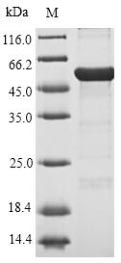Recombinant Pseudomonas putida Metapyrocatechase (xylE) represents a full-length protein expressed in E. coli, spanning 1-307 amino acids. The protein carries an N-terminal 10xHis-SUMO tag and a C-terminal Myc tag, which appear to simplify purification and detection processes. SDS-PAGE analysis suggests purity levels exceeding 90%, making it potentially suitable for research applications that demand high-quality protein preparations.
Metapyrocatechase functions as an enzyme in aromatic compound breakdown. It seems to play an important role in catechol's catabolic pathway. The enzyme catalyzes the oxidative cleavage of catechol to 2-hydroxymuconic semialdehyde, which may prove fundamental for bioremediation studies and research examining how microbes degrade environmental pollutants.
Potential Applications
Note: The applications listed below are based on what we know about this protein's biological functions, published research, and experience from experts in the field. However, we haven't fully tested all of these applications ourselves yet. We'd recommend running some preliminary tests first to make sure they work for your specific research goals.
Pseudomonas putida Metapyrocatechase (xylE) is a bacterial catechol 2,3-dioxygenase that requires precise folding and iron coordination for its enzymatic activity. The E. coli expression system is generally compatible with bacterial proteins, increasing the likelihood of correct folding. However, the dual N-terminal His-SUMO tag (∼20 kDa) and C-terminal Myc tag may sterically interfere with the enzyme's active site or oligomerization. While the full-length protein (1-307aa) contains all functional domains, the large tags may compromise substrate access and catalytic activity. The probability of correct folding is moderate, but functional activity requires experimental validation due to potential tag interference.
1. Protein-Protein Interaction Studies Using Dual-Tag System
Protein-protein interactions require a precise tertiary structure that may be compromised by the large dual tags. Results should be considered preliminary without confirmation using a natively folded protein. The large N-terminal SUMO tag and C-terminal Myc tag may sterically block interaction interfaces or cause misfolding, leading to non-specific binding or failure to identify genuine partners. If correctly folded, it could reveal physiological interactions, but results require validation with tag-free protein. The dual tags do provide technical flexibility for orthogonal validation methods.
2. Antibody Development and Validation Platform
This recombinant xylE serves as an excellent immunogen for generating antibodies against Pseudomonas putida metapyrocatechase. The full-length sequence ensures comprehensive coverage of the epitope. The dual tags provide additional epitopes for screening and controls for specificity testing. These antibodies will be valuable for detecting xylE in bacterial samples and environmental studies.
3. Biochemical Characterization and Enzyme Kinetics Studies
This is the critical first step to assess protein quality and activity. Techniques like size-exclusion chromatography with multi-angle light scattering (SEC-MALS) can determine oligomeric state, while enzymatic assays with catechol substrates can validate dioxygenase activity. However, the tags may sterically hinder substrate access to the active site, potentially yielding false-negative results in activity assays. These analyses are essential but must include activity validation to confirm functional integrity despite the tags. The high purity supports reliable biochemical measurements.
4. Tag-Assisted Protein Purification Method Development
This protein is ideal for developing and optimizing multi-step purification protocols. The dual-tag system allows testing of sequential purification strategies, tag cleavage efficiency, and comparison of different chromatography methods. This application focuses on the tags rather than the protein's biological function.
Final Recommendation & Action Plan
This dual-tagged recombinant xylE is reliable for antibody development and purification optimization but requires rigorous activity validation before functional studies due to potential tag interference. The immediate priority is Application 3 (Biochemical Characterization) to test enzymatic activity with catechol substrates and assess oligomeric state via SEC-MALS. If activity is confirmed despite the tags, proceed cautiously with Application 1 (Interaction Studies). Applications 2 and 4 (Antibody Development and Purification Optimization) can proceed immediately. For reliable structural or detailed functional studies, consider tag removal or the use of tag-free xylE. This systematic approach ensures appropriate use based on functional validation, with the understanding that the tags may limit biological applications but are advantageous for technical development purposes.






